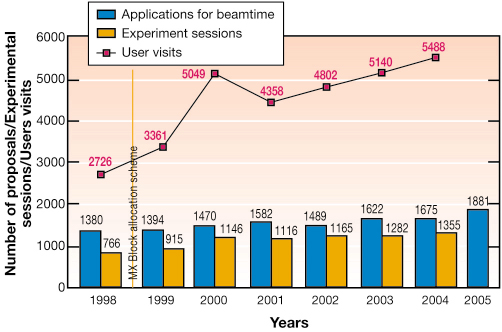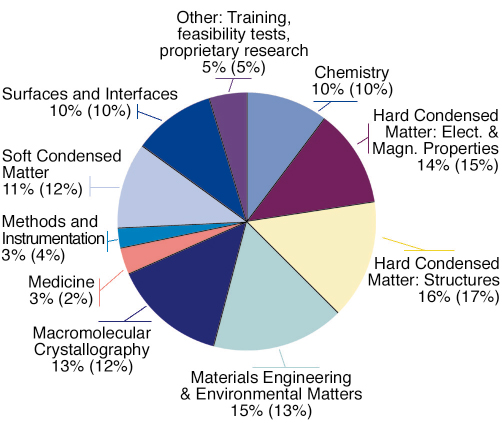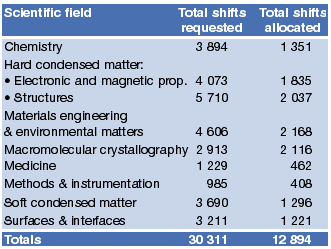User Operation
After 10 years of successful operation of the facility for scientific Users, the year 2005 again saw the full complement of 31 public beamlines, together with 10 additional beamlines operated by Collaborating Research Groups (CRGs) available for experiments by visiting user teams. Figure 169 shows the increase in the number of applications for beam time since 1998, and confirms that although the main beamline construction effort was complete by 1999, the number of applications for beam time continues to increase steadily.
 |
|
Fig. 169: Numbers of applications for beam time, experimental sessions and user visits, 1998 to 2005. N.B. Final numbers of experiments and user visits for 2005 were not available at the time of going to press. |
Proposals for experiments are selected and beam time allocations are made through peer review. Review Committees of specialists for the most part from European countries and Israel, have been set up in the following scientific areas:
- chemistry
- hard condensed matter: electronic and magnetic properties
- hard condensed matter: structures
- materials, engineering and environmental matters
- macromolecular crystallography
- medicine
- methods and instrumentation
- soft condensed matter
- surfaces and interfaces.
The Review Committees met twice during the year, some six weeks after the deadlines for submission of proposals (1 March and 1 September). They reviewed a record number of 1881 applications for beam time, and selected 781 (41.5%), which were then scheduled for experiments.
Features of this period include:
- increasing numbers of projects concerned more with applied than basic research in materials science, engineering, environmental and cultural heritage matters. As shown in Figure 170, experiments in these areas accounted for 15% of the total number of experiments carried out in the first half of 2005, an increase from 10% in 2002.
- the continued successful operation of the Block Allocation Group (BAG) scheme for macromolecular crystallography users. This scheme, designed to encourage groups of users to block together their multiple requests for beam time, and the scheduling of their experiments, encompassed 41 groups from Europe and Israel in 2005.
 |
|
Fig. 170: Shifts scheduled for experiments, March to July 2005, by scientific area (Percentages for 2004 in parentheses). |
Requests for beam time, which is scheduled in shifts of 8 hours, totalled 30 311 shifts or 242 488 hours in 2005, of which 12 894 shifts or 103 152 hours (42.5 %) were allocated. The distribution of shifts requested and allocated, by scientific area, is shown in Table 11.
 |
|
Table 11: Number of shifts of beam time requested and allocated for user experiments, year 2005. |
The first half of 2005 saw 2761 visits by scientists to the ESRF under the user programme, to carry out 652 experiments. Figure 169 shows the rapid rise in the number of user visits since 1998, the higher numbers in recent years reflecting in part the multiple visits made by macromolecular crystallography BAG teams. The peak in 2000 is due to a somewhat longer scheduling period, and correspondingly higher overall number of experimental sessions, and visits by users.
Overall, the number of users in each experimental team averaged 4 persons, and they stayed for some 4 days. Users responding to questionnaires indicate that they particularly appreciate the assistance they receive from scientists and support staff on beamlines, and smooth administrative arrangements, in addition to the quality both of the beam and of the experimental stations. Facilities on site, such as preparation laboratories, a canteen open 7 days a week, and the Guesthouse, also make an important contribution to the quality of user support.



